This Pad Thai recipe has the best flavor and is incredibly easy to make at home! Made with simple, authentic ingredients in just 30 minutes, it’s fast, flavorful, and vegan-adaptable!
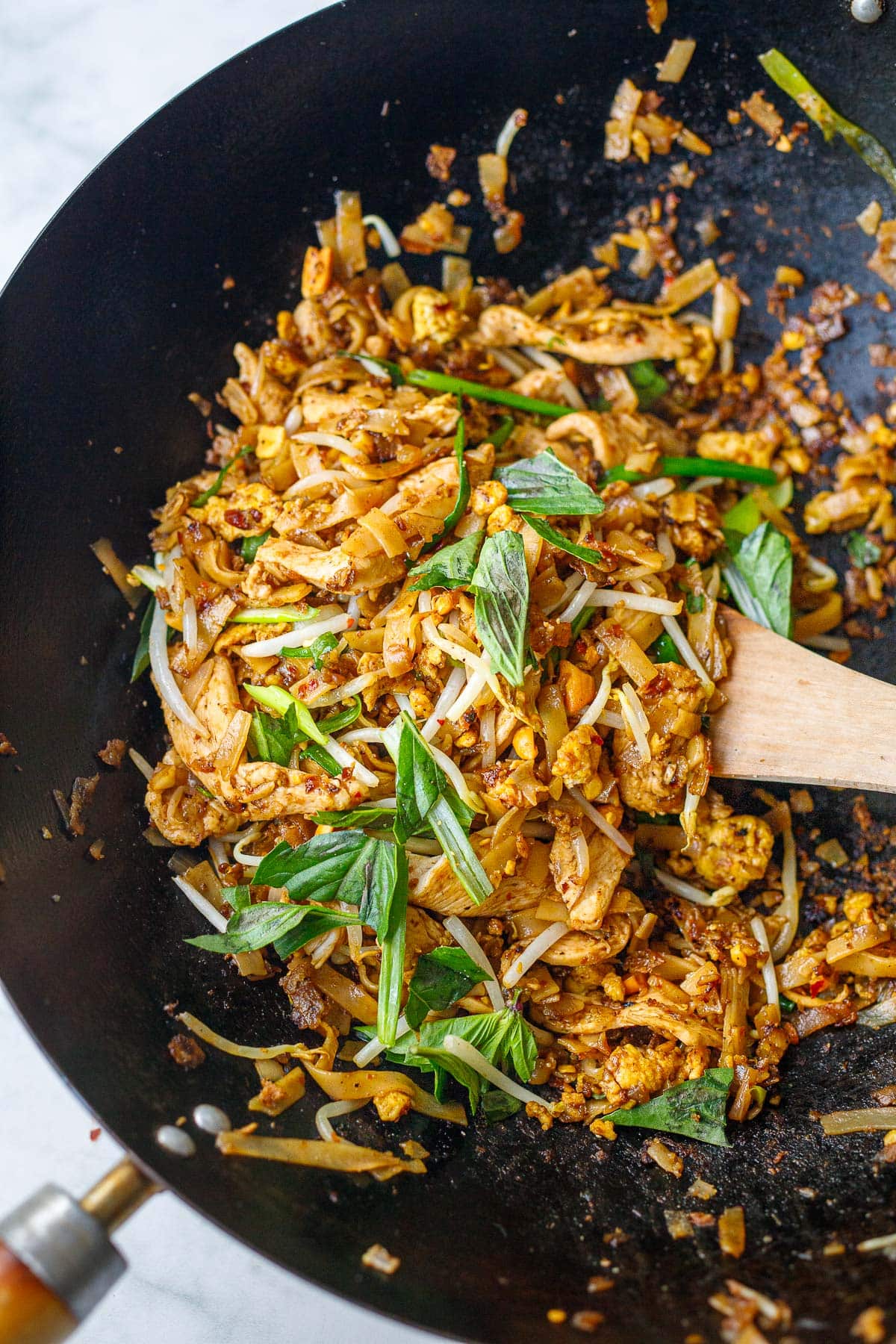
Pad Thai is one of the most popular and beloved Thai noodle dishes of all time! As a chef and Pad Thai connoisseur, I’ve had a lot of Pad Thai in my lifetime, here and all throughout Thailand. We’ve captured the authentic flavor you’ll find in Bangkok, while keeping the recipe simple.
What makes this recipe shine is our Pad Thai Sauce! It is flavorful and perfectly balanced; not overly sweet like many versions you’ll find here in the States.
But first, What is Pad Thai?
Pad Thai is a popular stir-fried noodle dish from Thailand made with rice noodles, shallot, garlic, scrambled eggs, and a protein; typically chicken or shrimp, in a flavorful tangy, umami Pad Thai Sauce.. It’s served with fresh bean sprouts, crushed peanuts, scallions and lime.
Why You’ll Love This Pad Thai Recipe!
- Best flavor balance! The Pad Thai sauce is a delicate balance between umami, sour and sweet. Most American versions are way too sweet; this one is just right.
- It’s adaptable! (This can be made with chicken, shrimp, tofu and /or veggies! Vegan-adaptable. )
- Quick and Easy– Once the ingredients are prepped, this takes 15 minutes of cooking time!
- Simple Ingredients. These accessible ingredients can be found in most grocery stores.
So yes, I may be biased but I think this Pad Thai tastes pretty darn amazing! Seriously! But don’t take my word for it, give it a try yourself and see what you think.
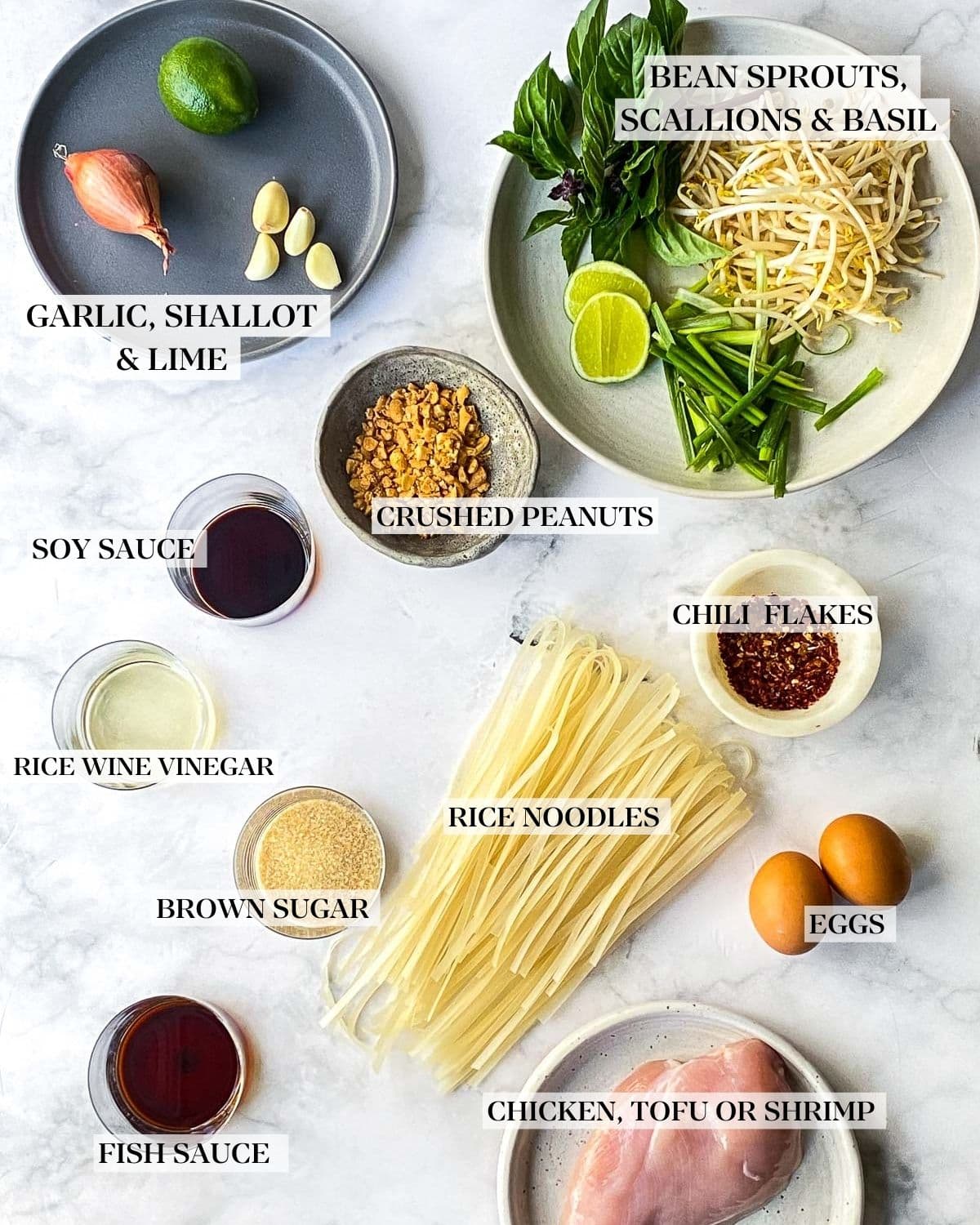
Pad Thai Ingredients
- Rice Noodles: Pad Thai is typically made with noodles called “rice stick”, which are rice noodles that are about 1/4 inch wide. Some brands are better than others- many fall apart when stir-frying. I have had the best luck with Thai Kitchen rice noodles. Make sure to soak, rather than boil, to prevent breaking.
- Protein: Add thinly sliced chicken breast, shrimp, or crispy Tofu, or leave out the protein and add stir-fried veggies. Extra firm tofu works best.
- Eggs: Traditional pad thai has scrambled eggs, vegans can leave this out.
- Garlic cloves and shallots: Shallots really elevate Pad Thai. I highly recommend shallots over onions if possible. Some versions use ginger, but in Thailand, they generally don’t.
- Fish Sauce—Fish sauce gives pad Thai its depth of flavor. Vegans can sub our vegan fish sauce!
- Soy Sauce: adds umami flavor and depth. Feel free to use gluten-free liquid aminos.
- Tamarind or Rice Vinegar: Traditional Pad Thai is made with Tamarind paste which gives it its sour component. Rice vinegar and lime juice can be used as an easy substitute.
- Sweetener: Palm sugar is traditional in authentic Pad Thai, we substitute brown sugar, or coconut sugar.
- Fresh Lime Juice– adds acidity.
- Garnishes: The garnishes make Pad Thai, adding texture and flavor. Sliced green onions, crushed roasted peanuts, fresh bean sprouts, Thai chili flakes and lime wedges and if available, Thai basil, all elevate!
THE Pad Thai SAuce!
The secret to the best Pad Thai Sauce is the perfect balance of salty, sweet and sour. Our sauce has delicious umami and depth, while not being overly sweet with a lovely tang. Letting the sauce caramelize in the wok for just a few seconds, adds a lovely smokiness.
- Fish Sauce- Fish Sauce can vary in degrees of saltiness from brand to brand. I like Red Boat Fish sauce, or Thai Kitchen Fish Sauce (found at most grocery stores) best for this recipe. (*Vegans can sub our vegan fish sauce and soy sauce.) If you are new to fish sauce, keep in mind, it has a little “funk” to it. You can start off lighter and replace the rest with soy sauce.
- Tamarind Water or Rice Wine Vinegar- authentic Pad Thai is made with tamarind water and lime juice to give it the sour component, but feel free to use Rice Wine Vinegar and lime to keep things simple here. See recipe notes for using tamarind.
- Sugar – In Thailand, it is traditional to use palm sugar but we use brown sugar, coconut sugar or regular cane sugar to add sweetness. Note: Do not be tempted to cut back on the sugar, the Pad Thai will be too sour.
- Soy Sauce -adding a little soy sauce adds even more depth. You can also use gluten-free liquid aminos!
How to make Pad Thai (Instructions)
Step 1: Soak the rice noodles. Pour boiling water over the rice noodles let them soak until they are soft and pliable (about 5-6 minutes) but not overly soft; drain.
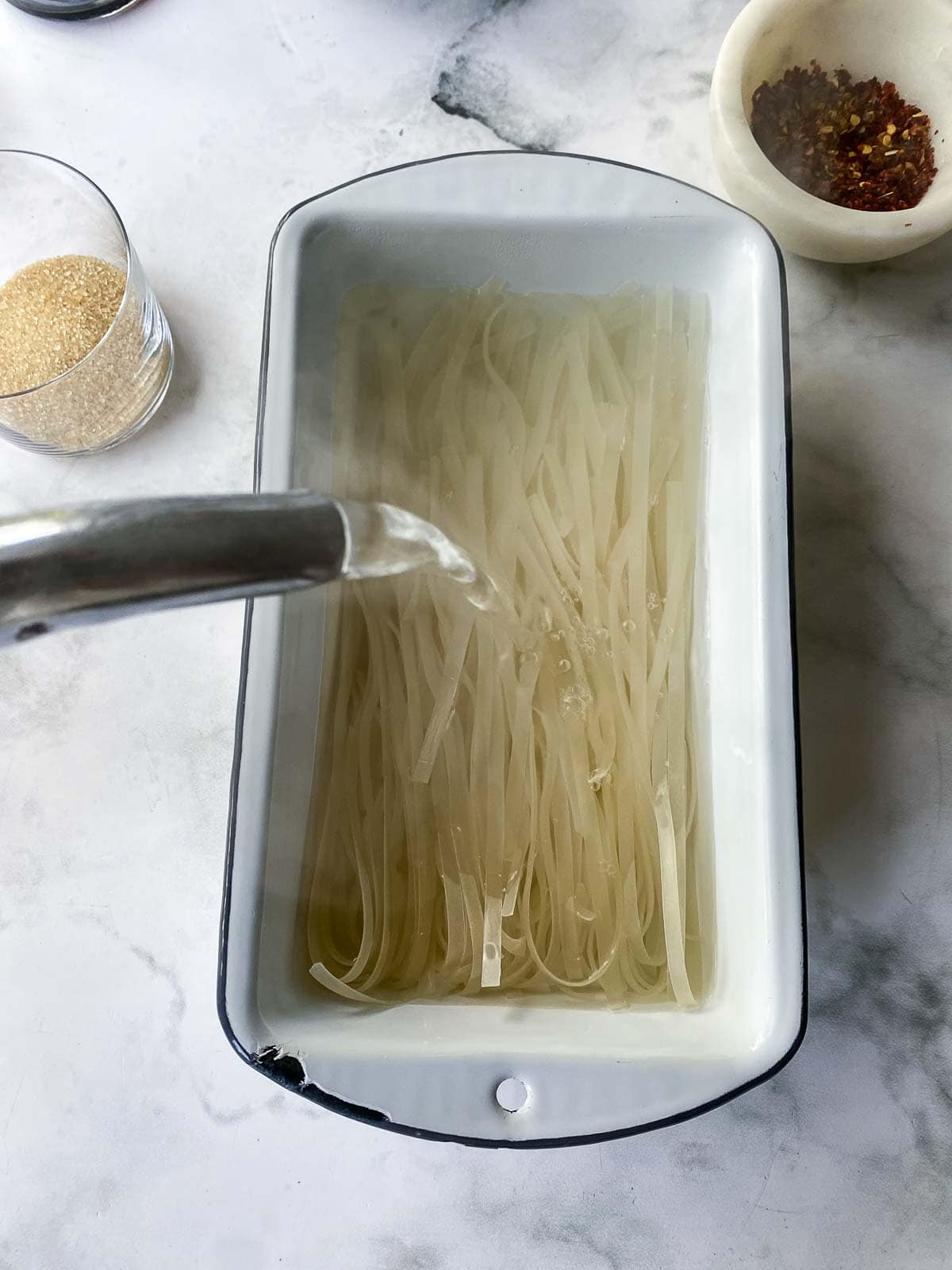
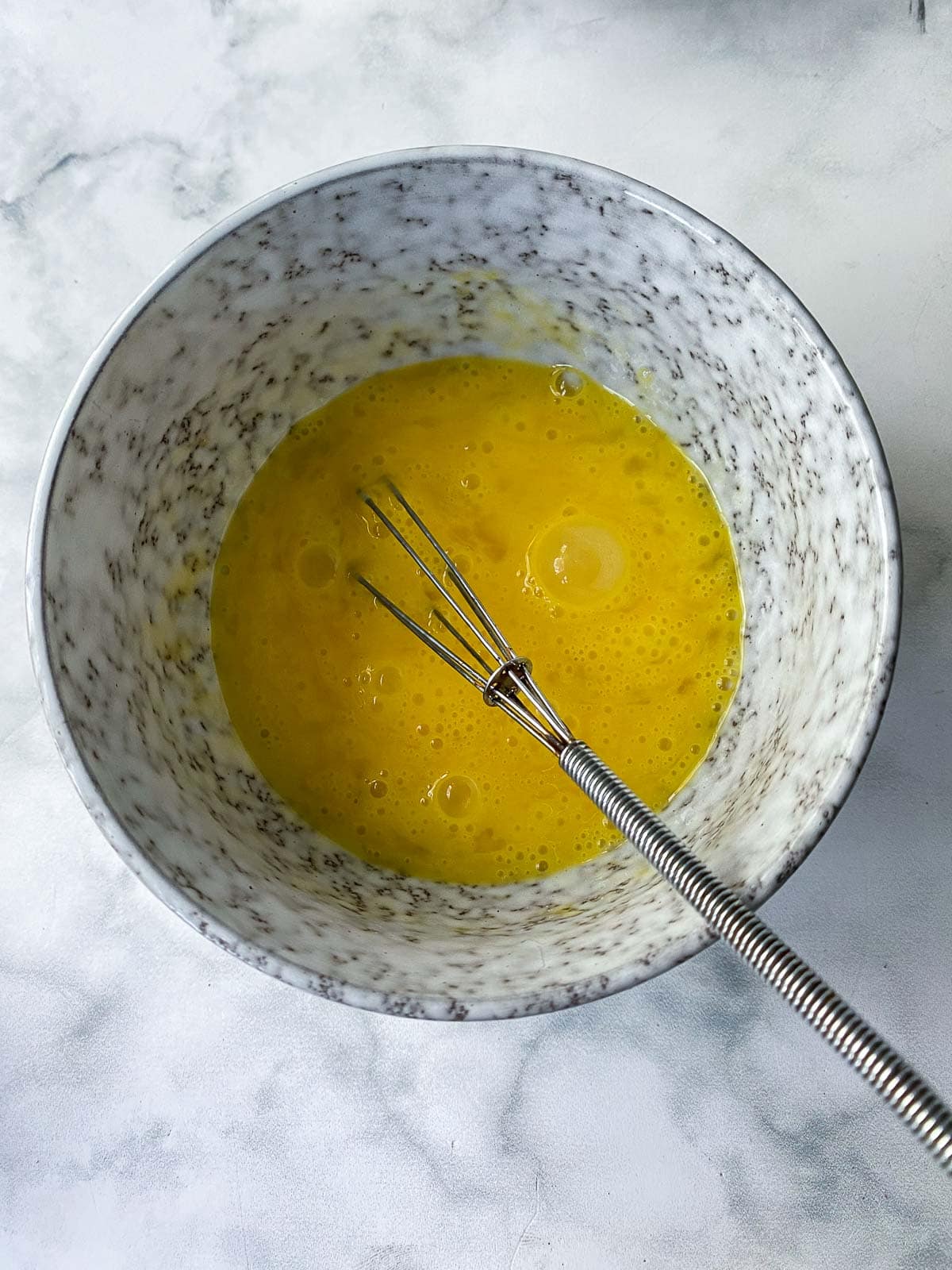
Step 2: Whisk the Eggs. Add a pinch of salt.
Step 3: Whisk the Pad Thai Sauce. Whisk the pad thai sauce ingredients together in a small bowl- keeping in mind, there is a delicate balance between salty, sour and sweet, so if you alter one ingredient, you may need to adjust the others. Make sure the sugar dissolves.
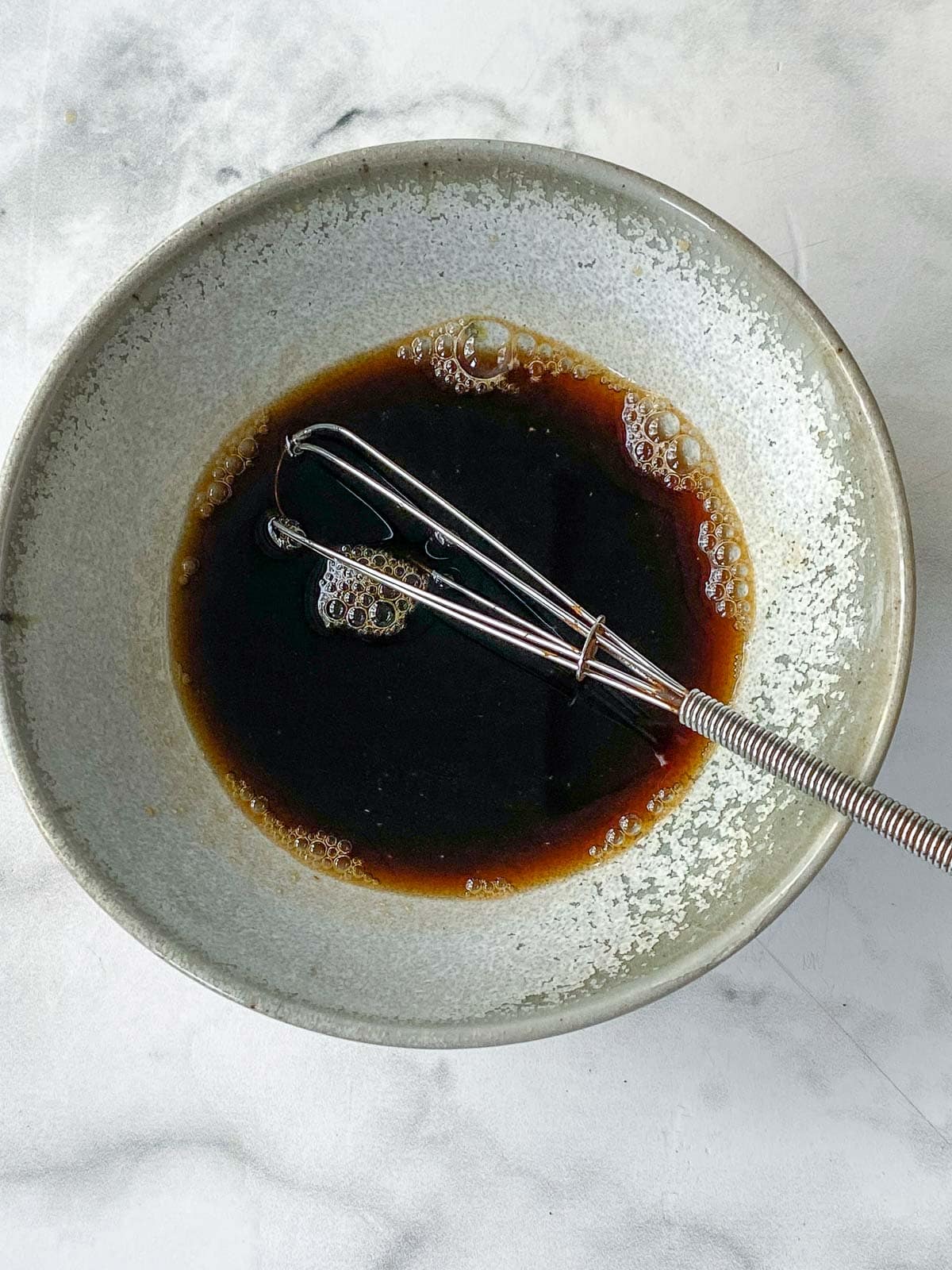
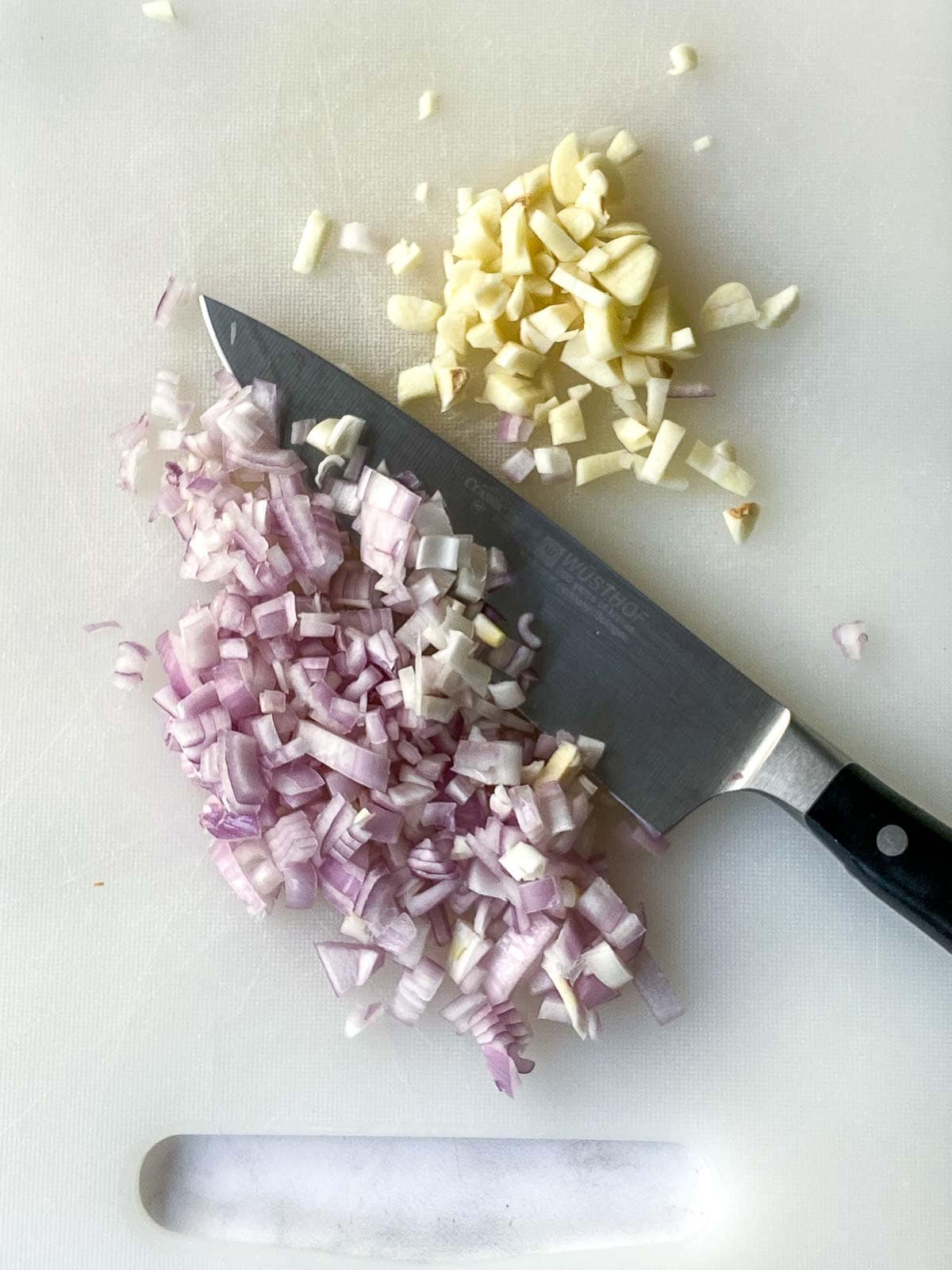
Step 4: Prep the Protein & Veggies. Chop the shallot and garlic and set aside as well as your protein. If adding veggies, chop or slice them small, so they cook quickly in the wok.
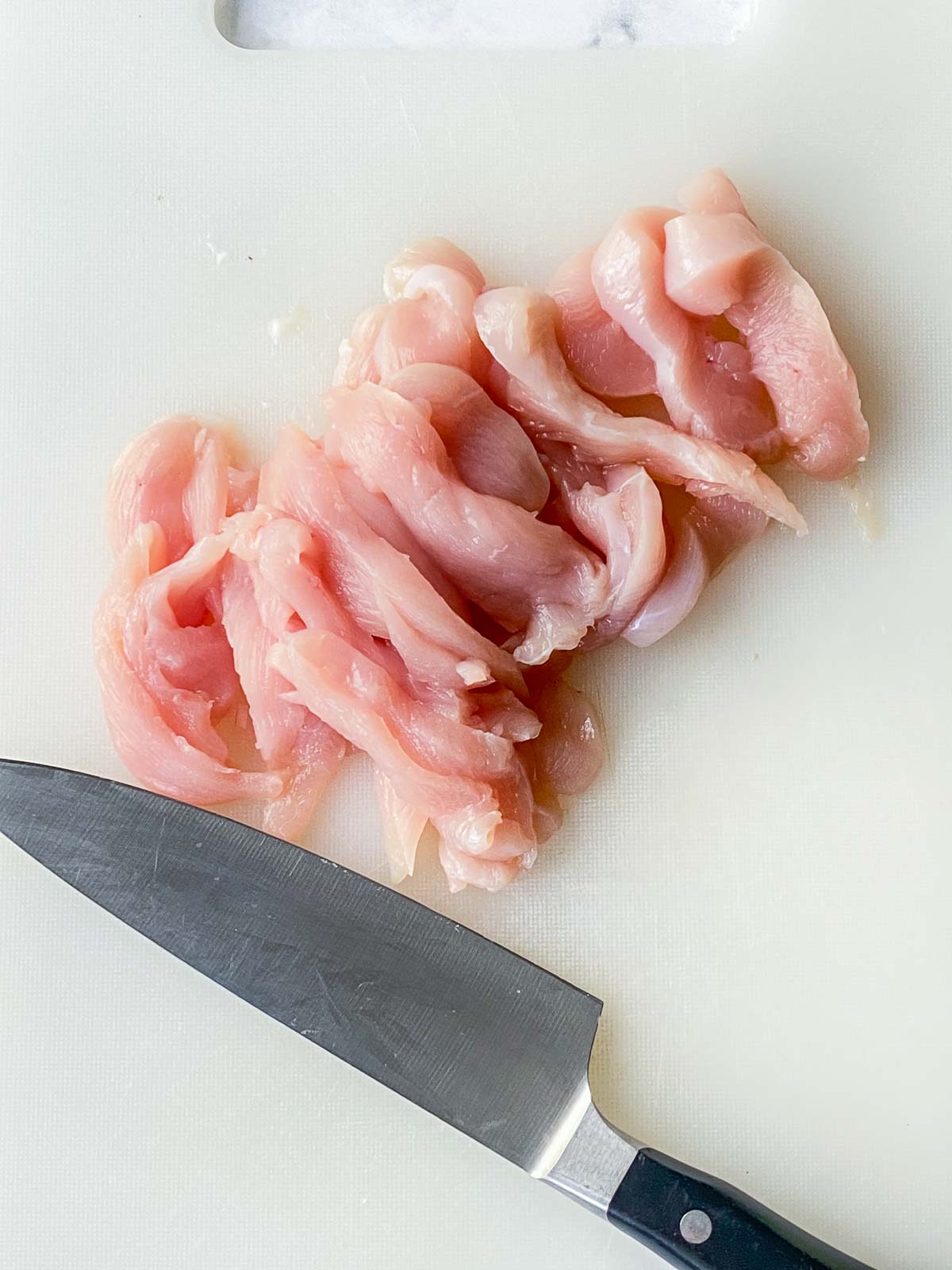
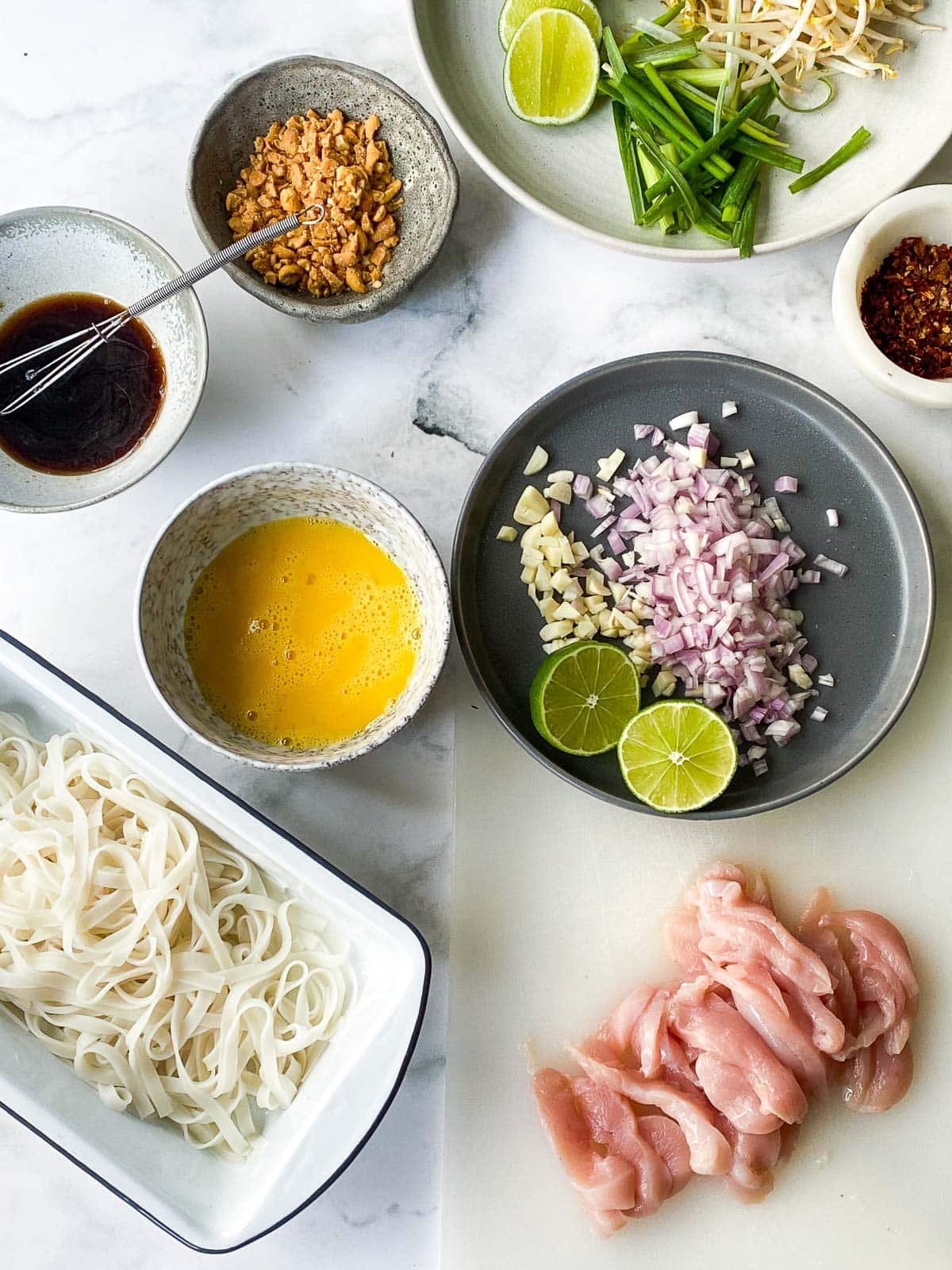
Step 5: Prep all your garnishes and have everything ready to go by the stove, keeping in mind the stir fry part will go quickly!
Step 6: Stir Fry! Season the protein with salt and pepper, stir fry until just cooked through and set it aside. If adding veggies, stir-fry these now and set aside as well.
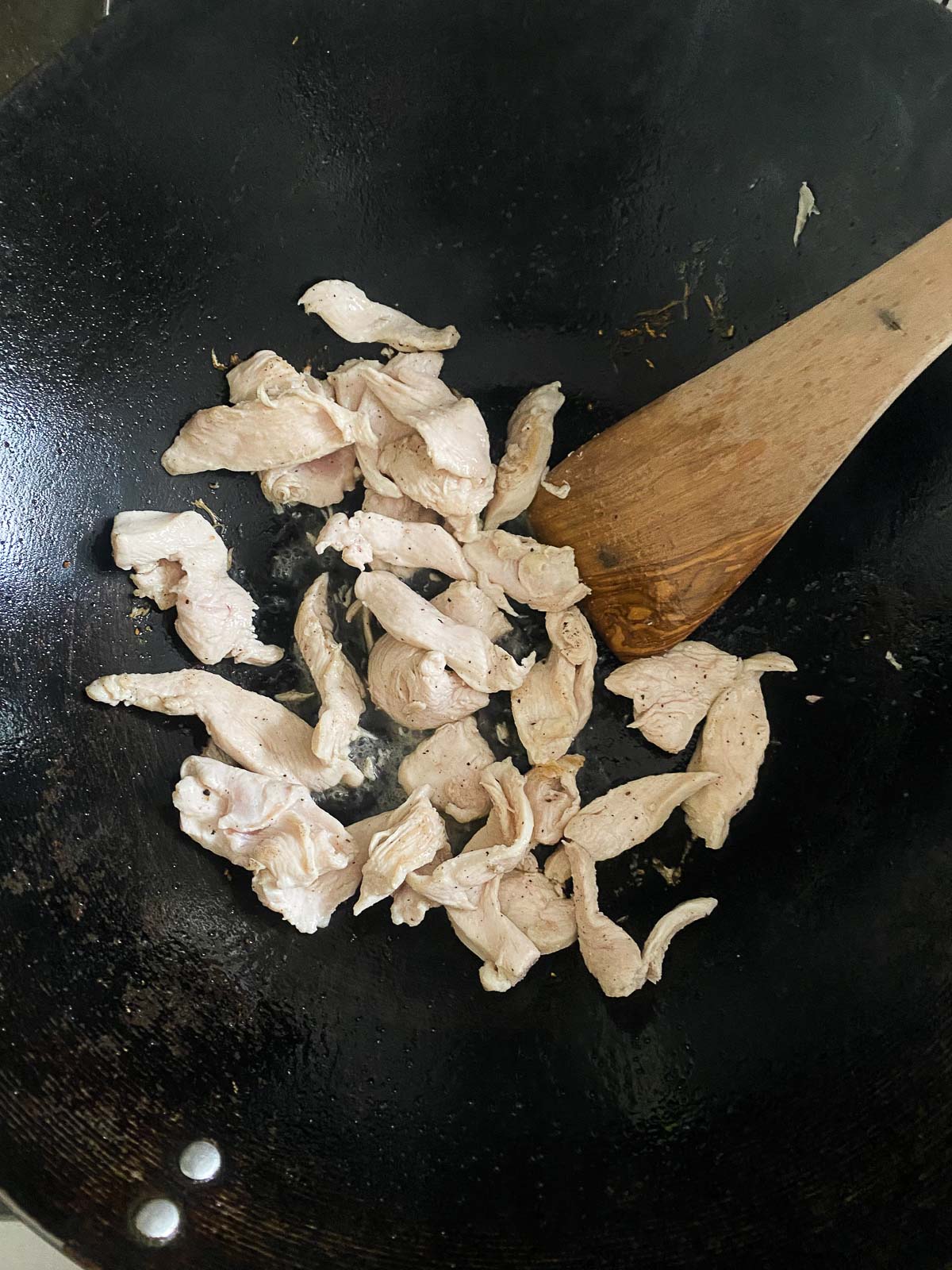
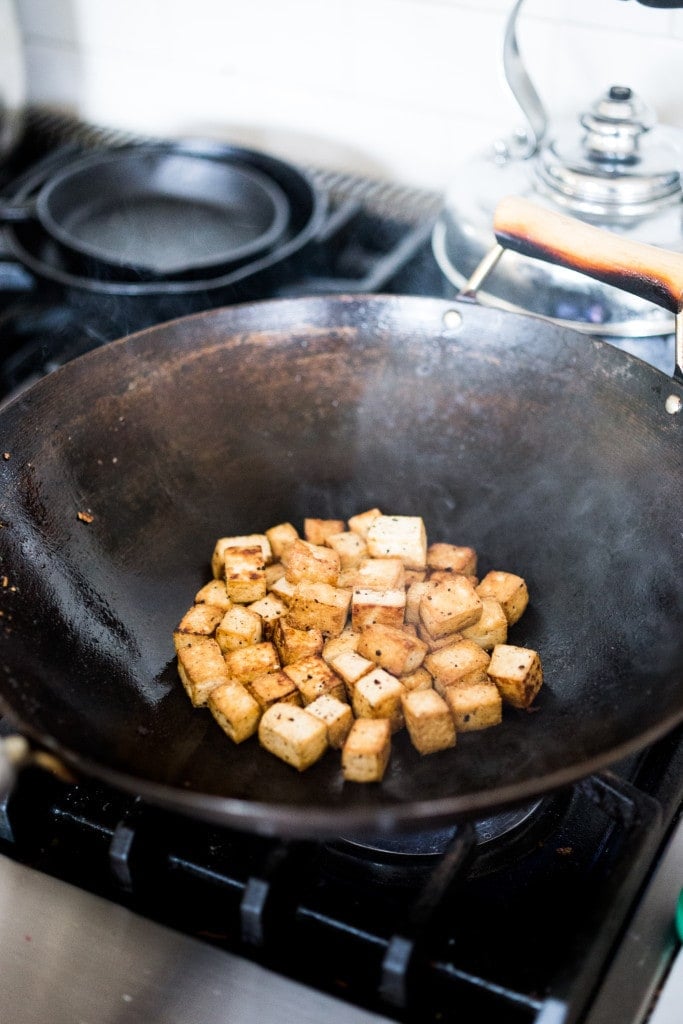
Add more oil to the wok and stir fry the garlic and shallots for just a couple minutes, scoot them over, add more oil if needed, and add the whisked the eggs, scrambling and breaking to bits.
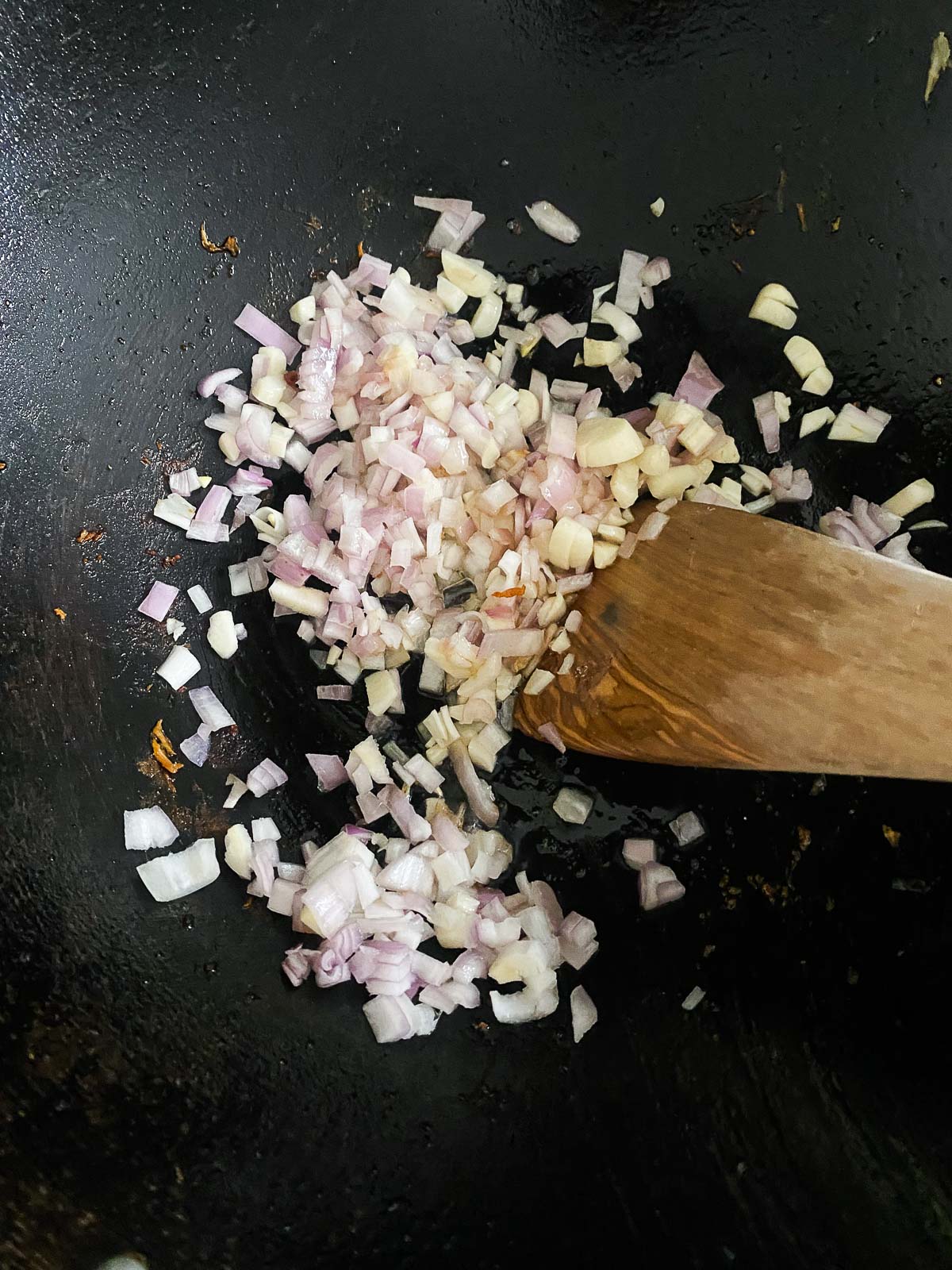
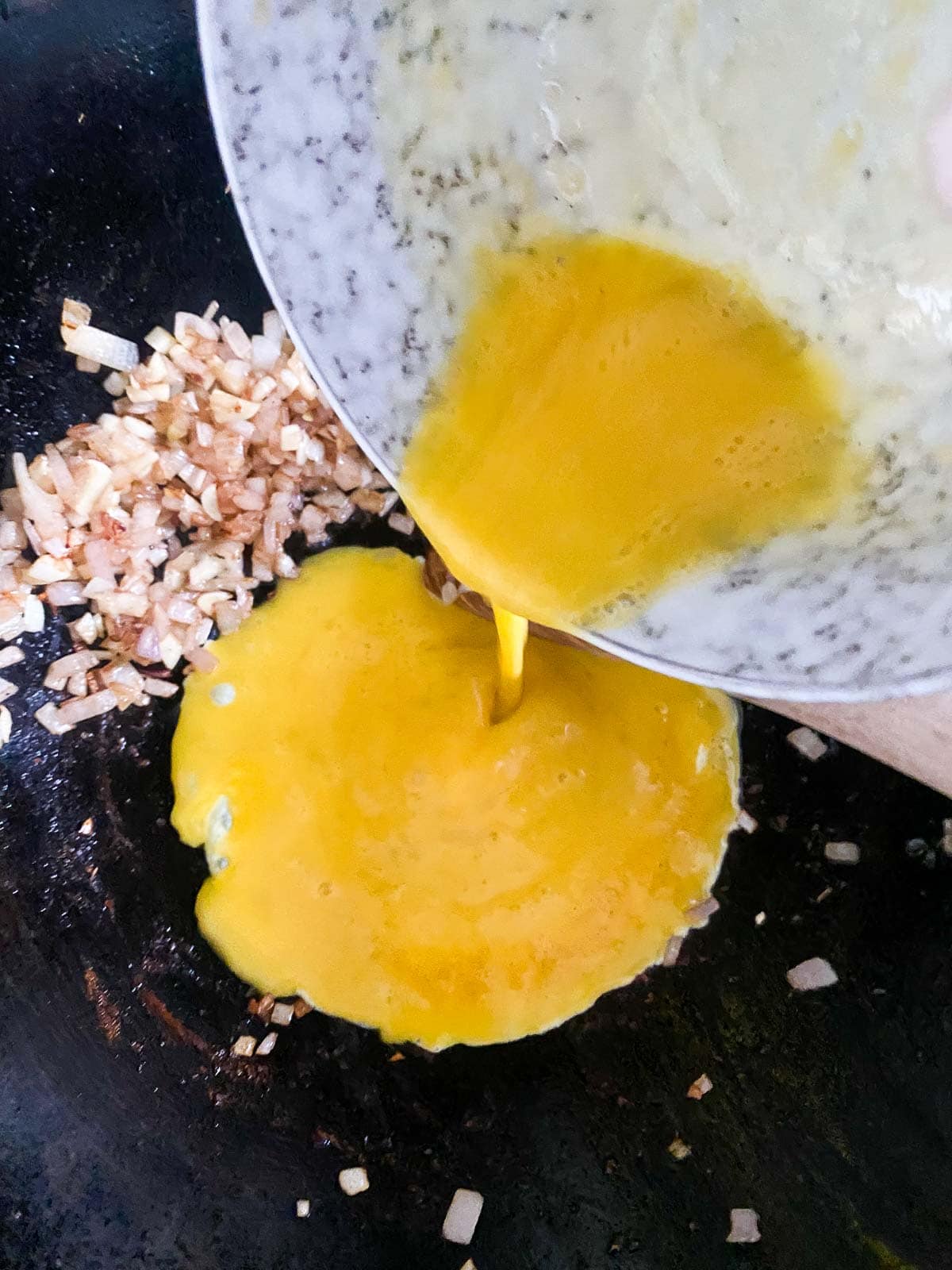
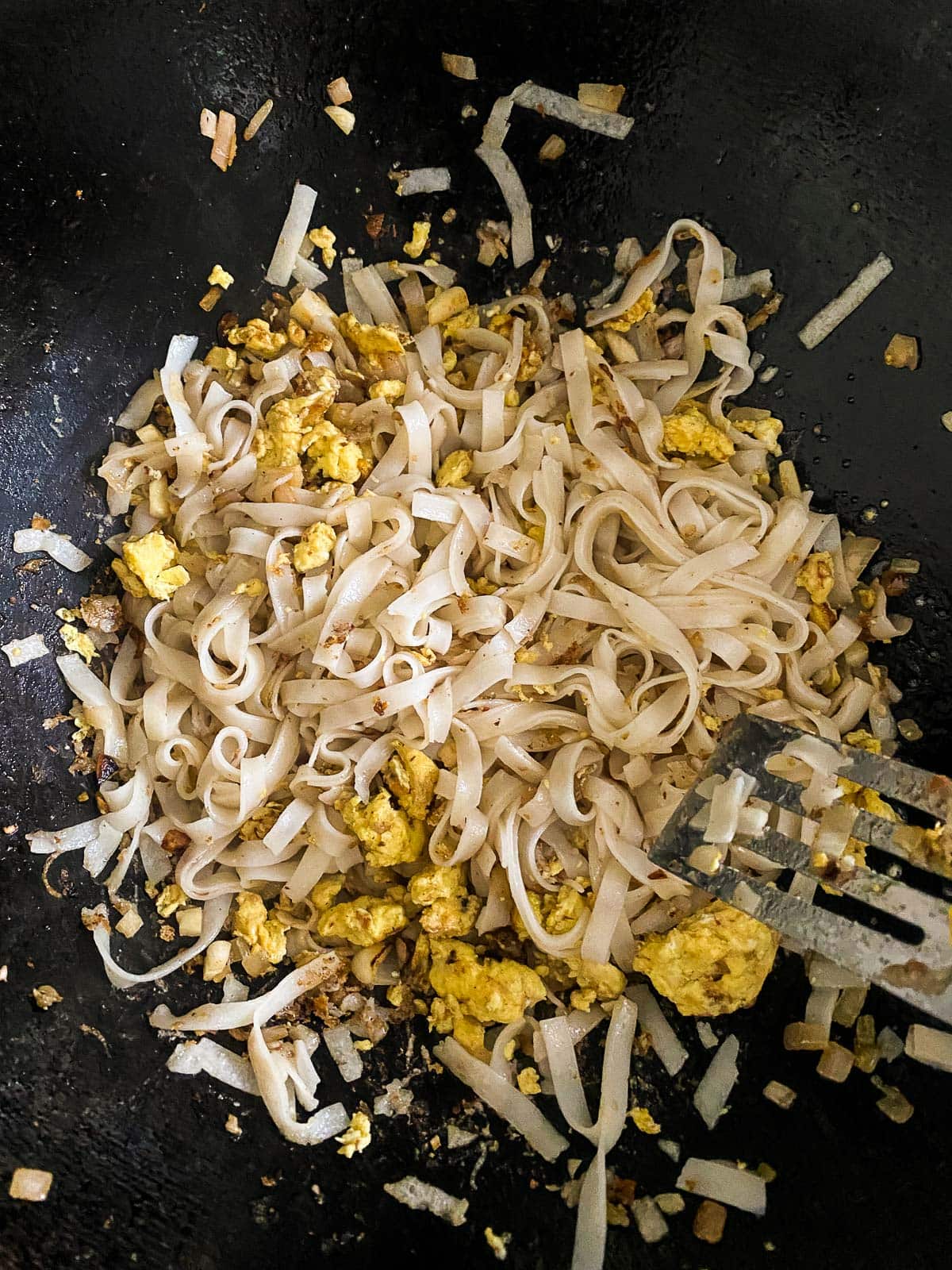
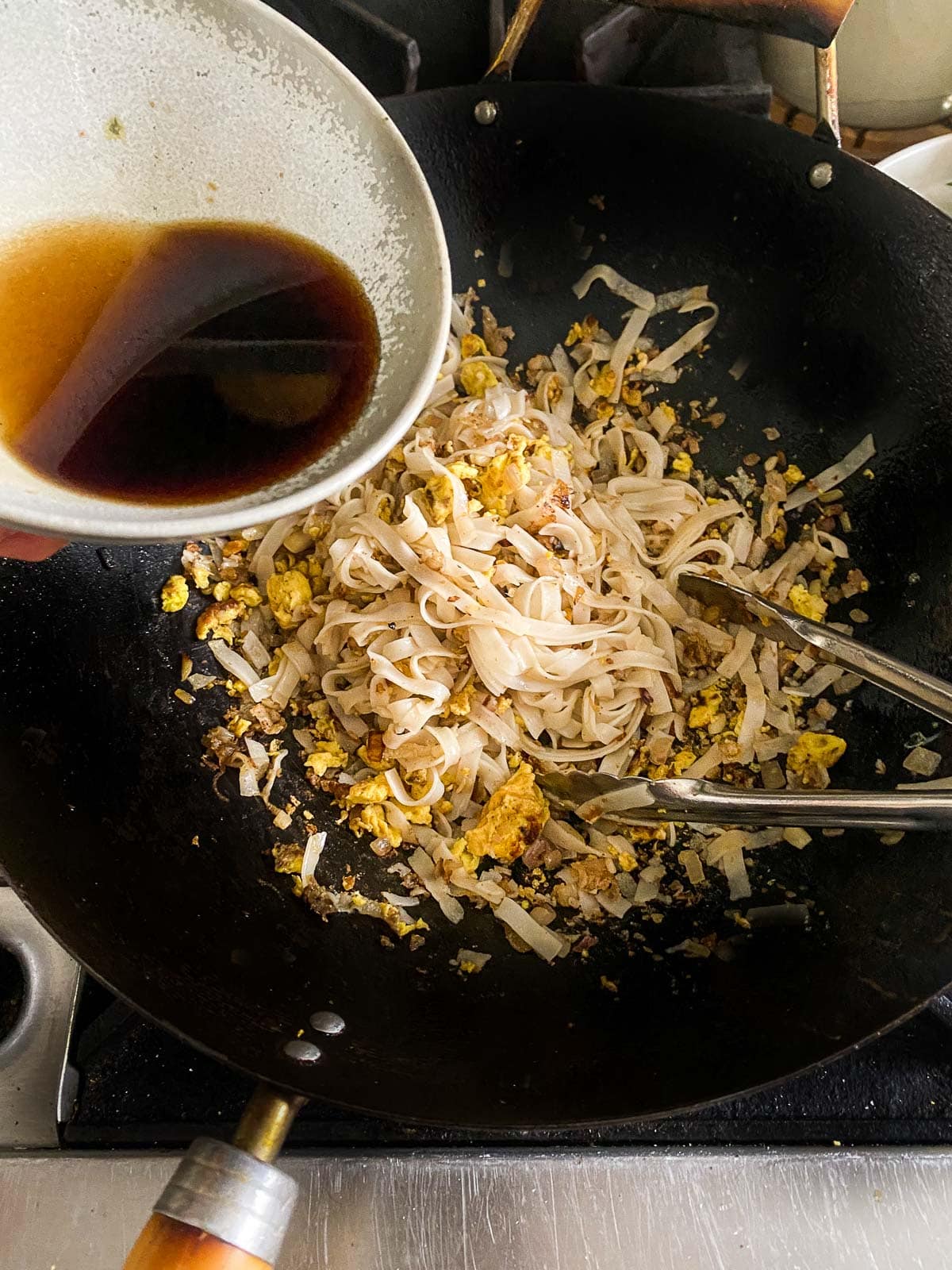
Scoot the eggs over and add more oil and stir fry the noodles, letting the noodles get a little crispy! Turn your hood on and pour in the Pad Thai Sauce. Let the sauce caramelize for 30 seconds, until you smell the sugar caramelizing. This will add great flavor!
Add back in the cooked protein and veggies, with some of the bean sprouts and scallions. Add a squeeze of lime.
*Taste and adjust salt, lime or sugar to taste. Find the perfect balance. See FAQ’s for troubleshooting the flavors.
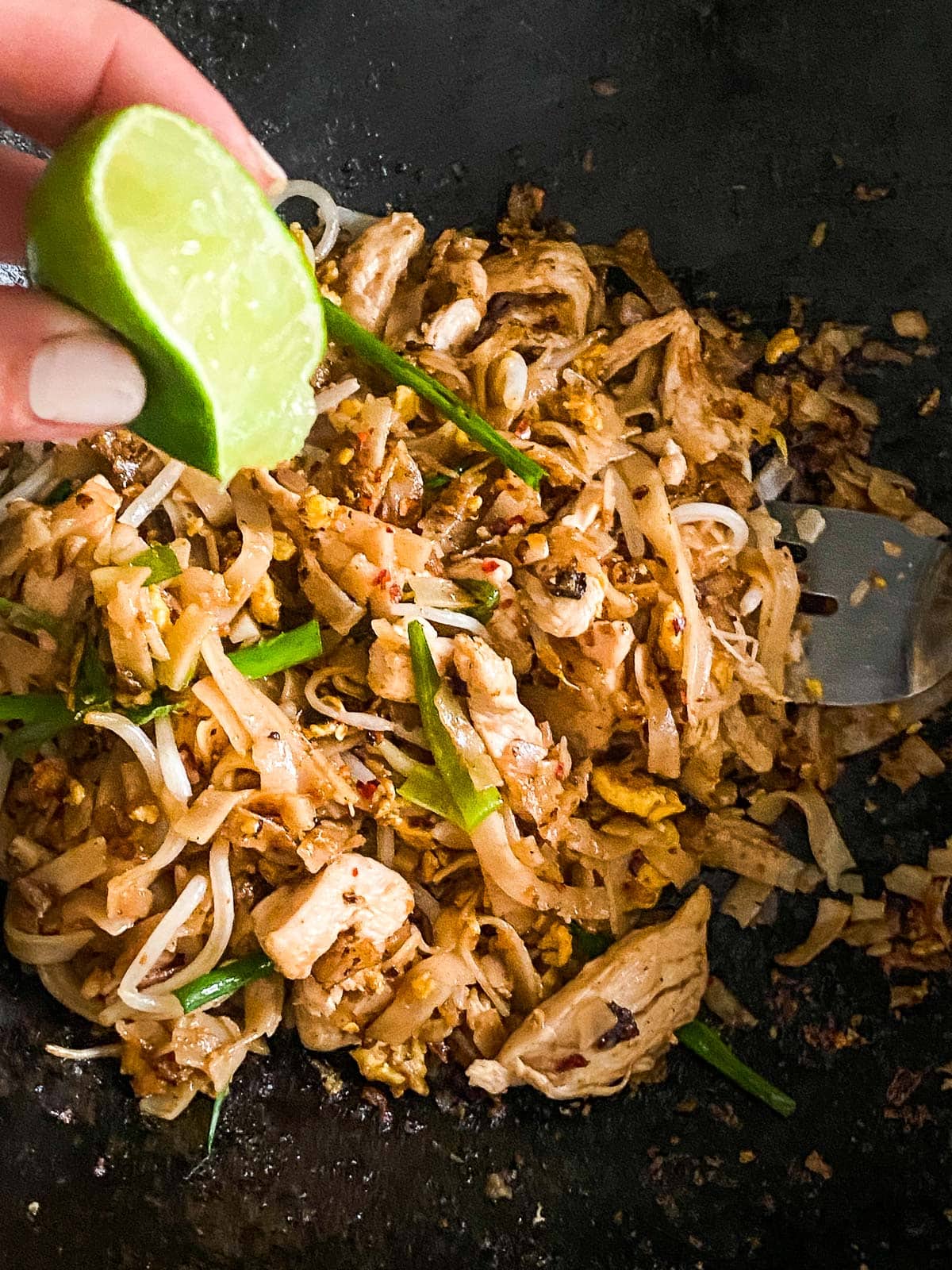
Step 7: Serve. Divide between 2-3 bowls and garnish with fresh bean sprouts, lime, wedge, crushed peanuts, chili flakes, scallions and basil.
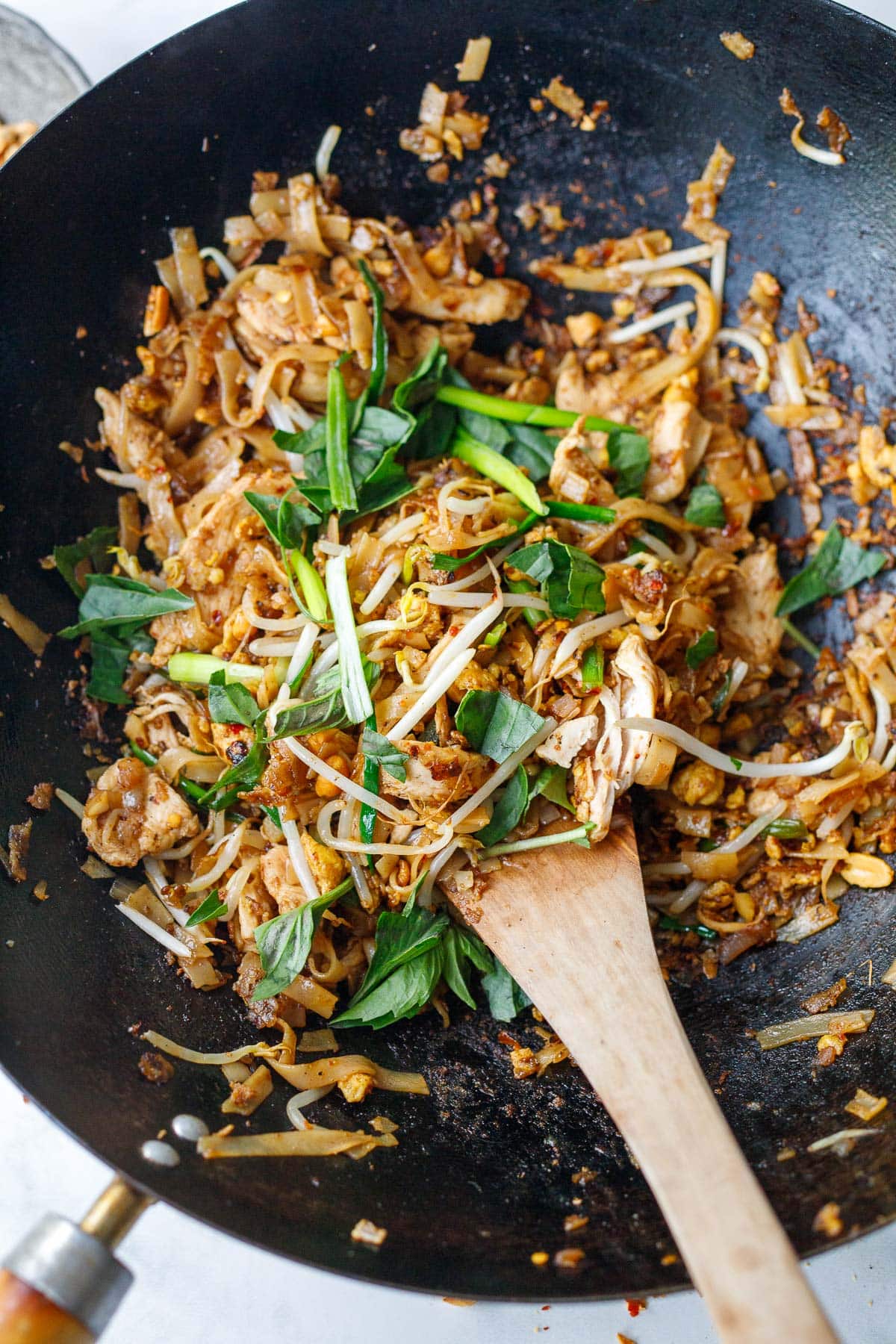
Serving Suggestions & Storage
Pad Thai is best served right after it is cooked. Leftovers will keep up to 4 days and best to reheat in a skillet or wok.
- Serve with lime wedges.
- Add fresh bean sprouts.
- Sprinkle with crushed roasted peanuts (or try this amazing Peanut Chili Crunch!)
- Add chopped scallions or Thai basil.
- Serve with Thai chili flakes, sriracha or chili paste for extra heat.
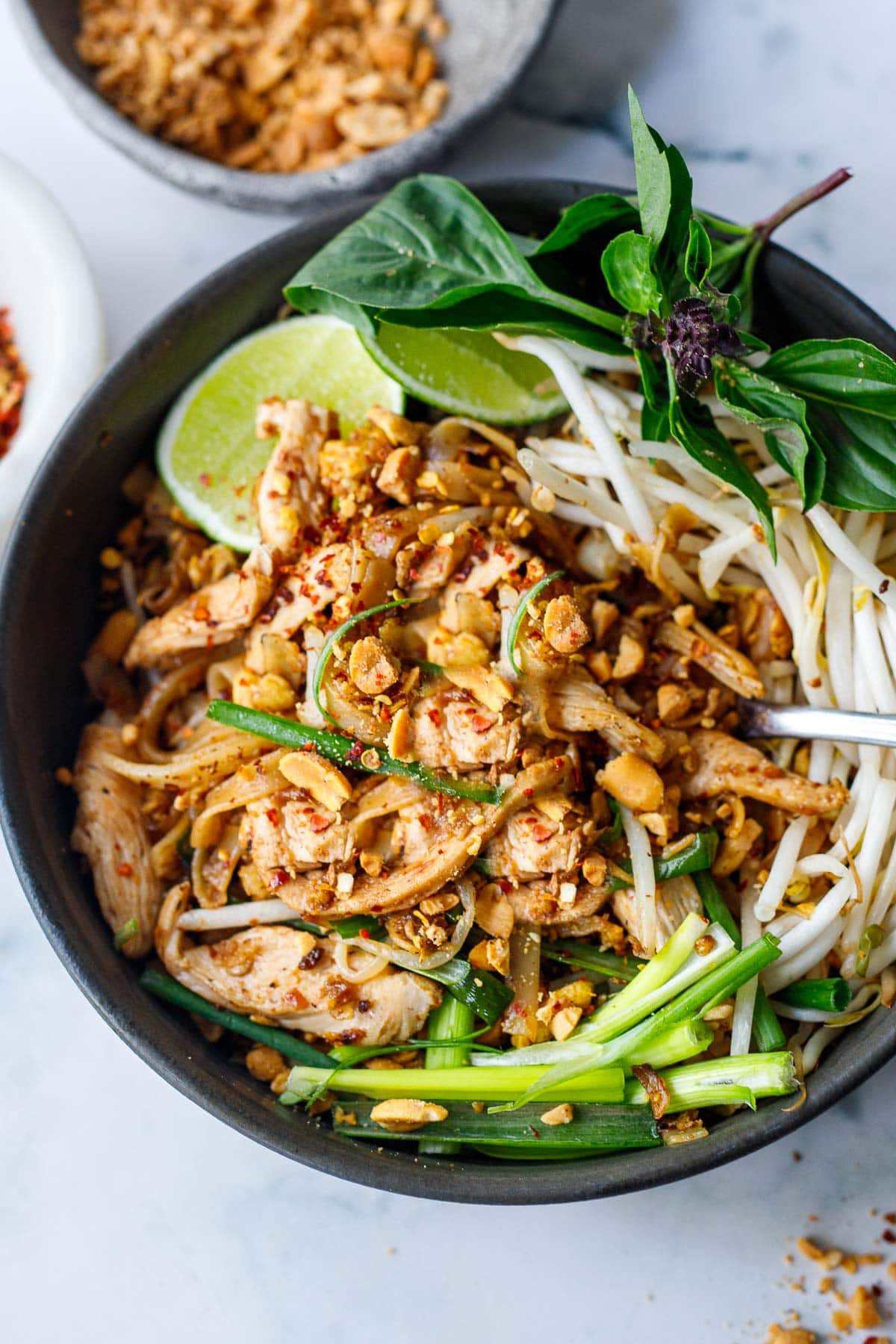
Chef’s TIPS
- Read the whole recipe through before you give it a go.
- Prep everything first, then place it near the stove. Cooking goes very fast here!
- Cut chicken very thinly to cut down on cooking time. Remember to cut across the grain, into ⅛ -¼ thin strips about two inches long.
- To lower calories, poach the chicken in a little salted water, until cooked through which just takes a couple of minutes. Then set it aside.
- Use shallot. Shallot adds so much flavor here- much more so than onion.
- Crispy noodles. Crisp up the rice noodles in the pan before adding the sauce.
- Let the Pad Thai sauce caramelize a bit in the wok, before turning off the heat. This is the secret to the best flavor- a smoky sweetness we all crave!
Pad Thai Don’ts
- Please do not add ketchup or peanut butter. This is not authentic and takes away from the dish.
- Don’t use white vinegar instead of rice vinegar. White vinegar tastes way more acidic and it will be overly sour.
- Don’t skip the sweetener– you will lose the balance of the dish. You will end up with fishy, overly sour, salty Pad Thai that tastes terrible. TRUST ME.
- Don’t make too big of a batch. The noodles are stir-fried. You want the noodles to get slightly crispy in the pan, and the sugars to caramelize, giving them that incredible smoky flavor- this is difficult to achieve if making huge batches.
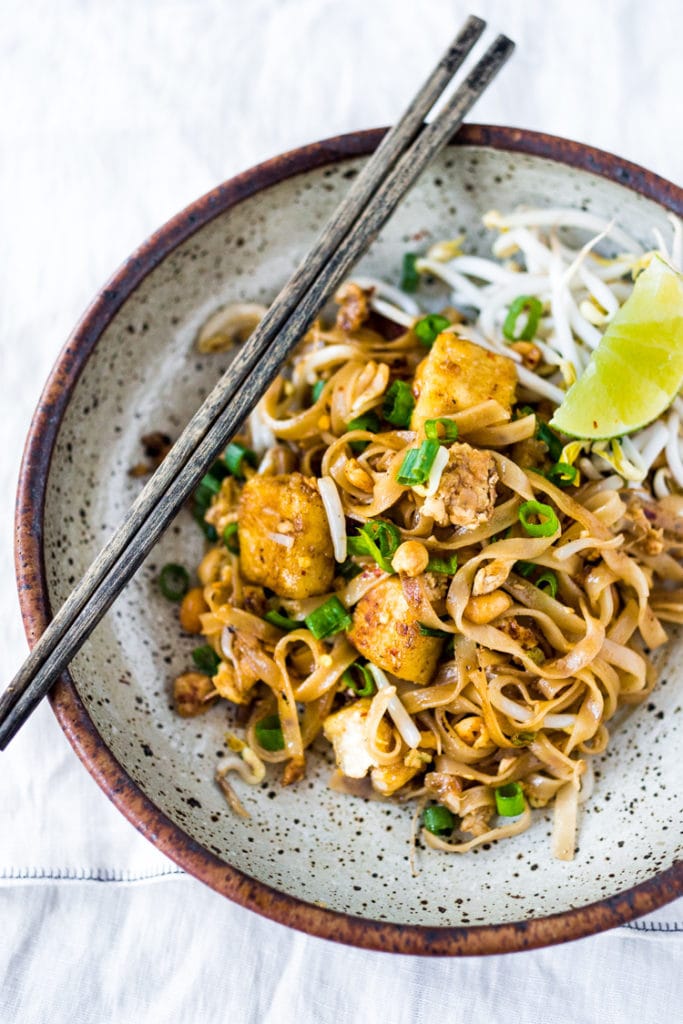
recipe Faqs
Yes, Pad Thai can easily be made vegan. Use vegan fish sauce or soy sauce and crispy tofu as the protein, and leave out the eggs.
The secret to the best Pad Thai is not overcooking the rice noodles, using a very hot wok, cooking in smaller batches so rice noodles can caramelize, and having the perfect balance of flavors- not too sweet, not too sour, and not too salty.
Peanut oil adds the best flavor, while avocado and coconut oil both have a high smoke point. Both work well here. Any neutral high heat oil will work.
Any quick-cooking vegetables that can be cooked in a wok can be added to Pad Thai- asparagus, green beans, matchstick carrots, bell pepper and bok choy to name a few. Feel free to add steamed broccoli too!
Try adding a little more brown sugar and vinegar to balance it.
Add a little more brown sugar to balance it. White vinegar will do this- so always use rice wine vinegar, tamarind water or lime, which are all less acidic.
Add more acid ( rice vinegar, tamarind water or lime juice) to balance it.
What to serve with Pad Thai!
I hope that after you make this, you’ll think this is the best Pad Thai recipe you’ve ever had too! 😉 Haha! Let me know in the comments below! 🙂
Happy weekend.
xoxoxo
PS. It is my hope that through cooking, we not only learn new ingredients and techniques but also learn more about the culture and people from which the food we make originates. Cooking can be a way of celebrating all our unique and beautiful differences. I’d like to believe expanding our repertoire in the kitchen can also expand our hearts.
More Favorite Thai Noodle Dishes!
Love Thai Cuisine? Try…
- 33+ Easy Thai Recipes!
- Authentic Tom Kha Gai (Thai Coconut Chicken Soup)
- 30-Minute Thai Green Curry
- Thai Larb Salad
How to make Pad Thai Noodles | Video
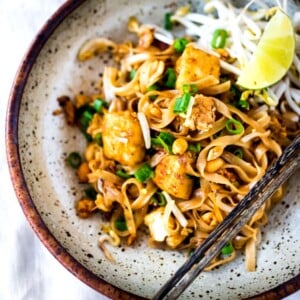
Easy Pad Thai (Chicken, Tofu or Shrimp)
- Prep Time: 15 mins
- Cook Time: 15 mins
- Total Time: 30 minutes
- Yield: 2 1x
- Category: Main
- Method: stir-fried
- Cuisine: Thai
- Diet: Vegetarian
Description
An easy, 30-minute recipe for Pad Thai made with rice noodles, your choice of chicken, shrimp or tofu, scrambled eggs, and an incredible “not too sweet” Pad Thai Sauce. Makes 2 large servings. Watch the video!
Ingredients
- 4 ounces rice noodles
- 3 tablespoons peanut oil, divided ( or use avocado oil, or coconut oil)
- 8 ounces chicken breast, tofu or prawns (peeled and deveined)
- salt and pepper to taste
- 1 large shallot, finely diced (much better than onion here)
- 4 fat garlic cloves, roughly chopped
- 2 eggs, whisked with a fork with a generous 3-finger pinch salt if vegan, leave it out)
- 1 lime
Pad Thai Sauce:
- 3 tablespoons fish sauce (see notes- or use vegan fish sauce)
- 3 tablespoons brown sugar (or coconut sugar, palm sugar, or regular sugar) see notes
- 3 tablespoons of rice wine vinegar (or tamarind water– see notes) do not sub white vinegar, it will be too sour.
- 2 teaspoons soy sauce (or GF liquid aminos like Braggs)
Garnish:
- lime wedges, fresh bean sprouts, chili flakes, chopped scallions, roasted peanuts, Thai basil
Instructions
- Soak the rice noodles. Place rice noodles in a shallow pan and cover with boiling water for 4-7 minutes, stirring occasionally (so they don’t stick together) until al dente; drain, rinse with cold water to stop cooking. They don’t have to be totally soft, just bendy and pliable.
- Whisk the two eggs in a bowl with a fork and add a generous, 3-finger pinch of salt. Set aside.
- Make the Pad Thai Sauce: whisk fish sauce, rice vinegar, brown sugar and soy sauce. (see notes) in a small bowl. Set aside.
- Prep the protein. Chicken: slice chicken into very thin strips and season with salt and pepper. Crispy Tofu: Blot tofu with paper towels pressing down firmly. Cut tofu into ¾ inch cubes, sprinkle with salt and pepper, and for extra crispy, dredge in a little corn starch. Shrimp: season with salt and pepper.
- Cook the protein: Heat 1 tablespoon oil in a large saucepan or wok, over medium-high heat. Sear the seasoned chicken, shrimp or tofu until cooked through. Set aside,
- Stir Fry: Gather your chopped shallots and garlic, whisked eggs, cooked noodles, cooked protein and Pad Thai Sauce around the stove. Heat a little more oil in the wok over medium heat, add shallot & garlic and stir fry 2-3 minutes. Scoot the shallot mixture to the side, add more oil, and pour in the eggs. Scramble and break them apart into little bits, and move them to the side. Add more oil, and the noodles, stirfry 2-3 minutes until noodles are soft and pliable and even a little crispy.
- Pour in the Pad Thai Sauce (turn hood on) stir everything together and cook 1-2 minute, then add the cooked protein and stirfry for a few more minutes. Just as you start to smell the sugar carmelizing, you are there! Squeeze with a little lime juice. Turn off heat.
- Taste. Adjust salt, lime, heat and sweetness to your liking; add salt, or soy sauce for more depth if you like, a squeeze of lime juice, chili flakes, or a pinch of sugar to taste.
- Toss in 1/2 the bean sprouts and roasted peanuts (or serve on the side) and sprinkle with chili flakes and scallions. Give one more toss and serve immediately. Divide among two plates.
- Garnish with more bean sprouts, fresh scallions, cilantro or basil, chili flakes, lime wedges and roasted crushed peanuts. Or make this Peanut Chili Crunch!
Notes
Fish Sauce: If you are not accustomed to fish sauce, or are using a brand you haven’t tried before (some are fishier than others) feel free to go lighter on the fish sauce– like 2 tablespoons. If going with less, replace it with soy sauce.
Poach the chicken. An easy way to cut back on the oil in the recipe is to poach the thinly sliced chicken breast in a little salted water, or broth for a few minutes, until cooked through. Drain and set aside. The thinner you slice the chicken the faster it will cook.
Tamarind: If using tamarind paste (instead of rice vinegar) make tamarind “water” by mixing 1 tablespoon tamarind paste with 2 1/2 tablespoons hot water. If using tamarind “concentrate” mix 1-2 teaspoons with 2 1/2 tablespoons water. Use tamarind water in place of the vinegar. Using tamarind is more authentic but not everyone has access to it. Tamarind is extremely sour so if unfamiliar, go light. You can always add more lime to taste.
Nutrition
- Serving Size: 1 ½ cups
- Calories: 409
- Sugar: 14.3 g
- Sodium: 1134 mg
- Fat: 14.2 g
- Saturated Fat: 2.1 g
- Carbohydrates: 47.4 g
- Fiber: 1.1 g
- Protein: 20.5 g
- Cholesterol: 165.4 mg
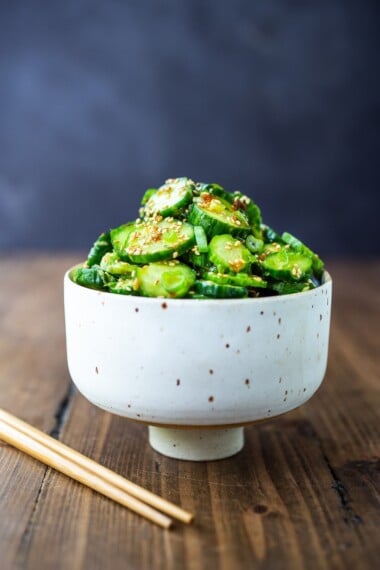
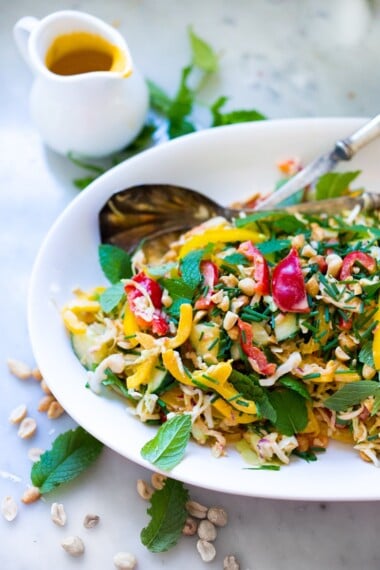
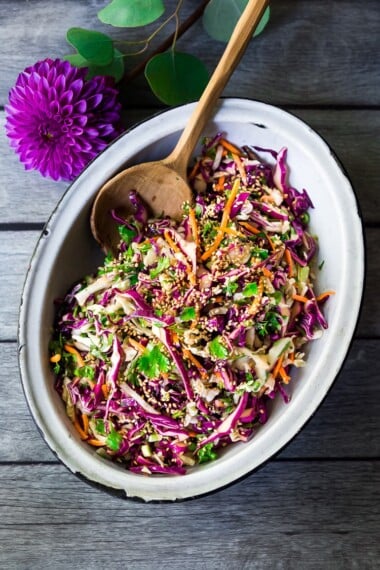
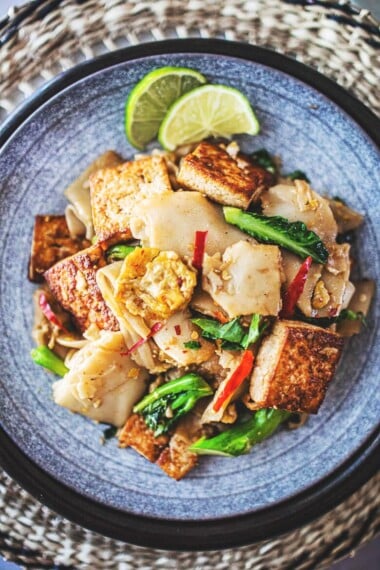
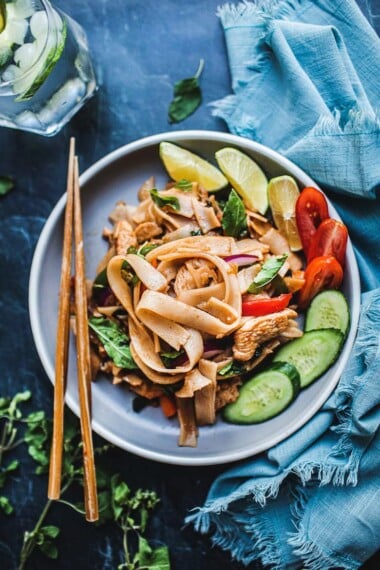
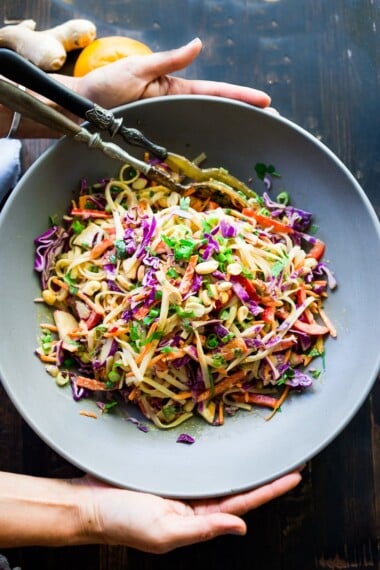
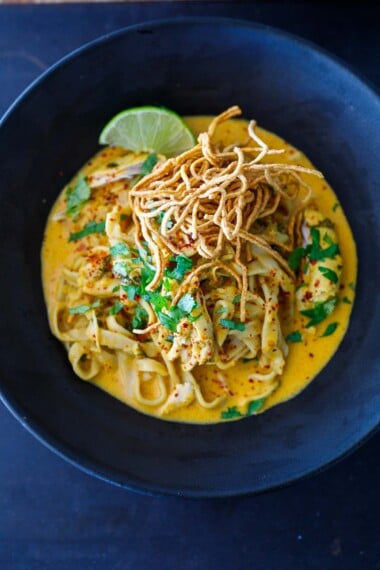
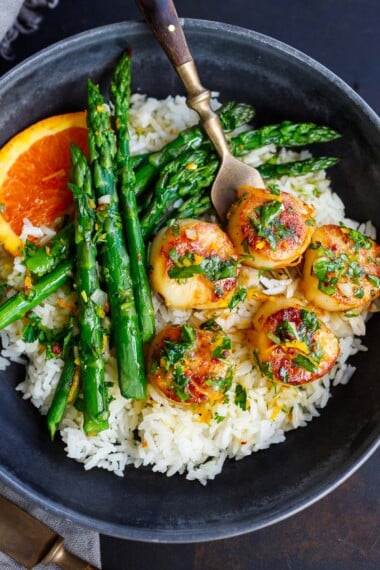
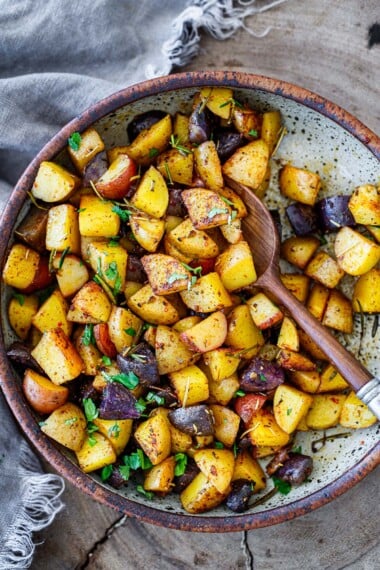
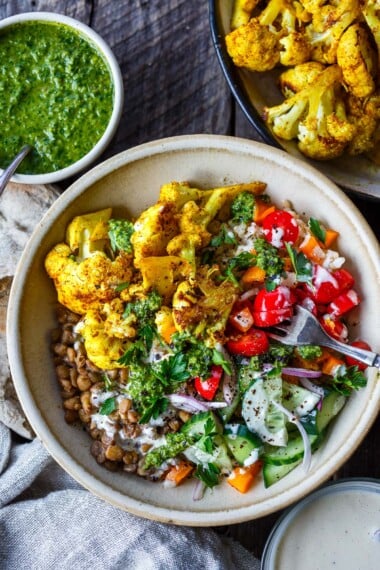
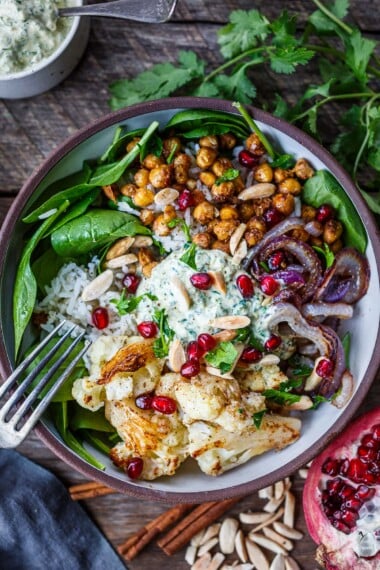
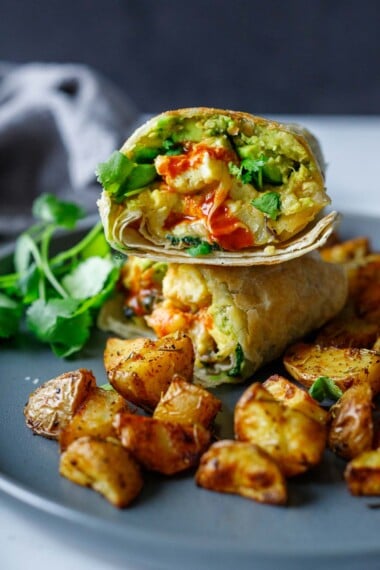
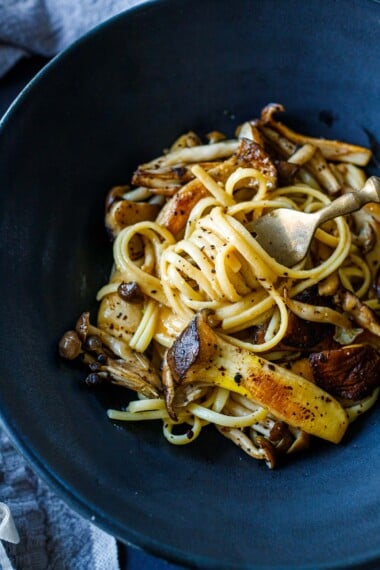
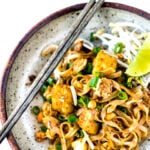
Hi Sylvia,
I made this for the first time today and it will be a “go-to” recipe in future.
The flavours were amazing and it was easy to make with your clear instructions.
If like me you’re only started cooking Asian foods, this is the place for excellent recipes which are easy to follow.
Thank you
Loraine
thanks so much Loraine!
Delicious umami balanced flavors! I used dried porcini mushrooms (couldn’t find shiitake) to make the vegan fish sauce. Highly recommend this recipe, guests loved it. Thanks for sharing!
Thanks Clayton- so happy you enjoyed this!
I love this recipe for lunch. It heats up well in the microwave & is so delicious! Thank you! Topped with Peanuts, bean sprouts, & sriracha- yummy!
Awesome Alisa!
Tried this recipe last night. It was very tasty but tasted nothing like the pad Thai we get from our local Thai restaurant. I was a little disappointed
Hi Kayla- this version of Pad Thai is much less sweet than many kinds you’ll get here in the states. It is actually more like what you’ll find in Thailand. If you like it sweeter, you can add of course. 😉
Absolutely delicious, I like to cook before work so it’s “fresh” but some recipes take forever to put together. This was quick, easy, and very tasty.
Awesome Becca!
This is my go-to pad thai recipe, I love it, it tastes like my favorite restaurant. I double the sauce for it.
Great to hear!
Delicious! I was worried about the liquid quantity when I added the sauce. Do you wait for it to reduce in the wok?
Hi Noelle- It will reduce a little- did it seem too saucy? Did you measure the noodles?
There was a lot of liquid and it didn’t reduce completely. I might try again with cooking the noodles less in hot water, then they should soak up more sauce.
Oh, that might it? The finished dish should just be a little saucy.
Recipe was great, and easy to follow. Although, either my rice vinegar is really strong or I put too much in, beacuse it did end up coming out tasting sour for me.
I’ll definelty have to give it another try sometime!
Thanks and Feel free to cut back on the vinegar Micah!
This was a big hit with the family! I was a little worried about the noodles not being soft enough after soaking them, but shortly after they hit the wok, the magic happened. I did the poaching technique you recommended for the chicken and was very pleased with it. Thank you so much!
Awesome John! Yes, it does feel like magic when those noodles soften!
Great recipe easy to follow.
Thanks, glad you enjoyed!
Overall amazing. I had the worst time though keeping the chicken moist when it was cooling. I always air on the side of situions with thicken though, so it might be a user error. Any recs to keep it juicy would be so appreciated!!!
Hi Madeleine-Keeping it moist when cooking do you mean?
Absolutely 5 stars. I have attempted pad Thai in the past with no success. But this one—chef’s kiss. So good. A bit labor intense but oh so worth.
Great to hear Tina-glad this worked for you!
Excellent flavor, easy to prepare. Made it with chicken coated in cornstarch for extra texture and added bell pepper strips. Will definitely make again. Thanks!
Perfect Barry!
Hello Sylvia!
I attempted your pad Thai recipe for dinner tonight with much hesitation as I was reminded of all my failed pad Thai attempts in the past. I even made Emerald dal and rice this afternoon just in case we need a backup dinner if the pad Thai turned out badly. Luckily enough, the emerald dal and rice are staying in the fridge tonight.
Your pad Thai recipe was really delicious… I can’t believe that I finally found THE recipe!! Thank you for an easy and delicious recipe. Definitely making it again.
Great to hear! thanks Swati!
This was spectacular. Directions were super clear and I did it in two batches which was absolutely the way to go. I am super popular with my two teenagers right now. This goes onto the regular rotation. Thank you!!!
YAY Amy! I love that! Glad this worked for you!
Omigod! Most flavorful Pad Thai I’ve ever made. Wow. Thank you so much Sylvia. We’ve been cooking exclusively from your blog, and everything has been a hit! (Tonia turned us on to it)
Awesome Wes, thanks and great to hear!
I have been craving Pad Thai for over a year, since we moved to a small beach town without a good south-east Asian restaurant. THIS WAS AWESOME! The flavors were bright and complex, just like the real thing in SE Asia. I followed the recipe exactly (except backed down a little on the fish sauce) and used tofu for the protein. My husband raved about how good it tasted. This will be on regular rotation at my house.
Glad you enjoyed this Nancy!
I have been craving Pad Thai for over a year, since we moved to a small beach town without a good south-east Asian restaurant. THIS WAS AWESOME! The flavors were bright and complex, just like the real thing in SE Asia. I followed the recipe exactly (except backed down a little on the fish sauce) and used tofu for the protein. My husband raved about how good it tasted. This will be on regular rotation at my house.
I have attempted pad thai previously, and it came out a globby mess. This recipe walks you through the steps in more detail so that the noodles separate and absorb more flavor. I used the tamarind paste rather than vinegar because I found it easily at the store, and I am glad I bought it because I will be making this many more times.
Glad this worked for you!
Needs more colour, next time will add carrots & snow peas cut into matchstick size for some colour. Very light/white colour. Otherwise good.
Yes,feel free to add more or other veggies- I like red bell pepper here too!
Can you use ponzu sauce instead of fish sauce
Hummm. I can’t quite picture it here, but who knows, it might work fine! Fish sauce is really salty, probably saltier than Ponzo, so you may need to season with more salt at the end? Give it a try?
Very easy, very tasty. Instead of shallot I used a leek from my garden, and plain ramen noodles. My husband said it was better than a restaurant, and my toddler loved it, too. Oh, and I garnished with a candied lime slice!
Awesome Lucy!
I failed in the first round, should have read the hints at the bottom.
I did the double recipe. My noodles were too soft. They got too soft during the time in the pan. And I used too much tamarind. My tofu, I followed the instructions, did not brown. It fell apart, the package said it was for stir fry. I got stuck at the pan bottom. Sorry, don’t have a wok, had to use a skillet. I will try again.
Sorry this was challenging. Second time around will be easier, I promise! Allow the tofu to crisp up enough and it should release itself from the pan. 😉
I’ve been craving pad thai but the idea of strapping my three and two year olds into the car while i’m seven months pregnant to pay $14-17 for a plate of pad thai felt like a lot of work. This recipe makes it sooo easy and delicious! it doesn’t use any ingredients that are hard to find, and it came out great. I think it tasted even better the next day. Thanks for such a simple recipe to address my pad thai fix 😀
Thanks Yolanda! Glad this was an easier solution for you!
THIS IS THE BEST PAD THAI RECIPE EVER!! it tastes like my favorite pad thai from home & it was so easy to recreate at college in my kitchen!! thank you for this easy and insanely DELICIOUS recipe !!
Great to hear Faith!